Line segment is a spatial awareness logic puzzle invented in the USA. Whilst it can look a little daunting at first, it’s actually very straightforward to learn.
In a hurry? Jump to: Rules / Tips / Worked Example / Video Tutorial / Download Free Puzzles / Books
Here’s a very small example puzzle:
The aim of the puzzle is to fill every cell with lines that can run either horizontally, vertically, or diagonally. Naturally, there are some rules.
Here’s what the earlier example looks like once it’s been solved:
This very small puzzle is particularly easy because there are no diagonals. Most puzzles are larger and include diagonal lines.
Solving Line Segment puzzles is largely a process of elimination. Here are some tips that should help you get started. Below, we’ll work through a larger puzzle from start to finish.
Let’s put everything into practice and work through a real puzzle.
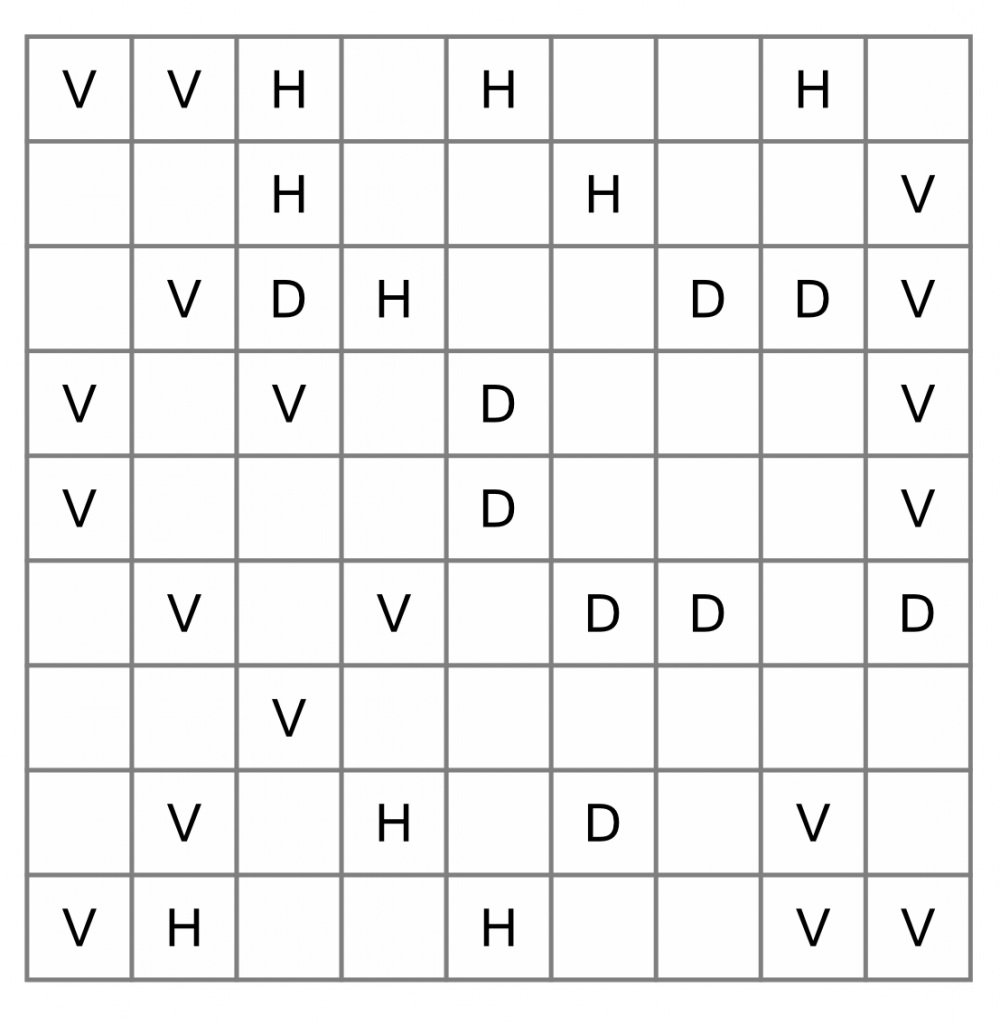
Here’s the grid we are going to solve. We’ll begin at the top left and work across, marking out horizontal and vertical cells. As we do, we are bound to pick up some ‘quick wins’ - sections we know we can complete. We’ll ignore diagonals for now because they are more complicated.
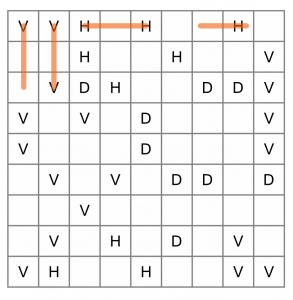
You can see we’ve worked across the top row, and that’s already allowed us to eliminate several cells. The first cell is a V, and we know it must descend at least 3 cells vertically. Maybe it connects to the next V below it, maybe not, we don’t know. The same thing goes for the V in the second cell.
When we get to the H, we know we must go at least 3 cells to the right (can’t go left), so that knocks out the next H.
The final H in the top row is an interesting one; we don’t know whether it incorporates the right-most cell or not, but as it must be at least three cells wide, it must include the cell to its left. So we can bar those two.
Let’s continue along the next row.
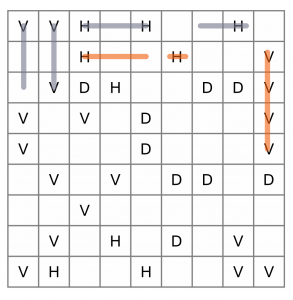
We can bar three cells with the first H (can’t go left so it has to go right). We don’t yet know if the second H connects to the first or not, but either way we can bar it.
The V at the end must connect to the others below it.
At this time, we still cannot determine what goes in the two empty cells in the top row. Maybe they connect to the Hs, or maybe they are part of diagonals. We’ll have to wait and see. In the meantime, we’ll continue working down the puzzle. Let’s do the next three rows, still looking at Hs and Vs, and leaving the Ds alone for now.
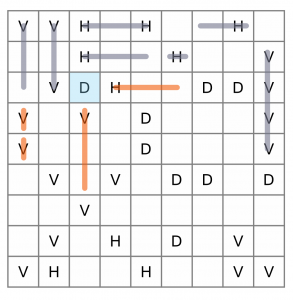
The H is easy – it’s hemmed in by Ds on either side so it’s a no-brainer. The three Vs can be marked out, but we don’t yet know whether they connect to the others below them. We’ll find out later.
Before we move to the bottom of the puzzle, let’s look at the D which I’ve highlighted. I know I said we aren’t looking at diagonals yet, but this one’s interesting because it’s hemmed in on all sides except two, and one of those is not a valid move. Can you see which? The only possible place we can put a valid line (ie one at least 3 cells long) is to the bottom right. So we might as well put that in now...
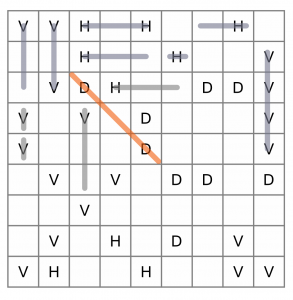
Having that diagonal is going to help us by eliminating other possible placements later. For now though, we’ve moved more than halfway into this puzzle, so let’s switch to the bottom and work up from there. By working from outside in, we are making the constraints of the puzzle work in our favour. We’ll just do the bottom row for now.
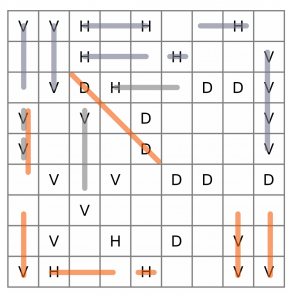
The first V must go up at least three cells. At this point we can see that the only way to make a valid vertical line with the two remaining Vs in that column is to connect them together plus a cell below, so we can draw that in too.
The first H in that bottom row must be at least three cells wide, but we don’t yet know if it connects to the second, so we’ll just put a bar through that.
The stacked Vs in the penultimate column are connected and must include at least one more cell. The final V is a no-brainer because it’s hemmed in above by the D.
Now we can look at the last H and the four remaining Vs.
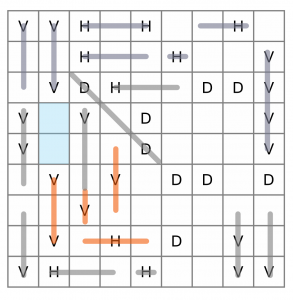
The first two Vs must be connected. If we draw in the H, which has to be three cells wide because it’s hemmed in on both sides, then we can see that the V in the third column up must connect to the one above it we already drew in - there’s nowhere else for it to go.
That leaves one V in the fourth column, and because of the diagonal we put in earlier, we know it must be three cells high.
We can go back and look at the two cells I’ve highlighted in blue. These cells are now cut off from the rest of the puzzle – they can’t be reached by any possible diagonals. There are only two of them, so they can’t form an independent vertical either. The only way we can fill them is to connect them to the verticals above and below, so we’ll do that now.
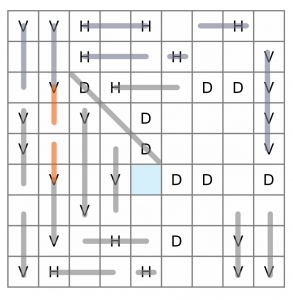
At this stage we have marked off all the H and V cells, and filled in all our quick wins. We even managed to sneak a diagonal in there. Where next? Well, if we examine the remaining empty cells, we can see that almost all of them could be part of several different lines. For example, the top-right cell could form part of the horizontal line to its left, or it could be a diagonal. There’s a block of six empty cells near the middle towards the right – they are full of potential. They could be two horizontal lines, or parts of diagonals, or possibly even part of a vertical in one case.
The cell highlighted in blue is a different case though. It can’t be a horizontal because it’s hemmed in that way, and it can’t be a vertical because it’s only got one free cell below it. It must be a diagonal, and there’s only one direction we can draw a valid line from it. Let’s draw that in.

There are a few ways we can advance from here, but we’ll stick close to the edges because of the built-in constraints. The highlighted D could be drawn in two ways – from its top-left to bottom right, or it could form the bottom of a diagonal going up and to the right (both possibilities highlighted). Can you work out which is the correct line? It has to be the one going up and to the right, because if we went the other way, we would be locking off the cell immediately below the D. So we can draw in the correct diagonal, and complete the H on the bottom row as well.
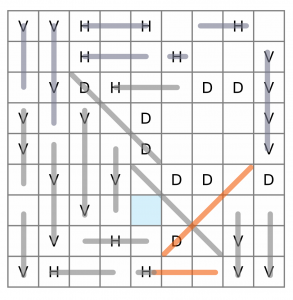
This gives us another constrained cell (highlighted). There’s only one way we can draw a line on that, and that’s by going up and to the right diagonally.

We don’t know if that diagonal is three or four cells long, so we’ll just draw three for now. (Note: If we think about two moves ahead, it’s pretty easy to see it must be four cells long. The fourth cell could potentially be part of a horizontal line, but that would cut off a cell below it. We’re keeping things simple here and not thinking too far ahead, so we’ll just draw it three cells long for now.)
Working methodically back up the puzzle, we have a D (highlighted) on the right that can only go one way, so we’ll add that next.
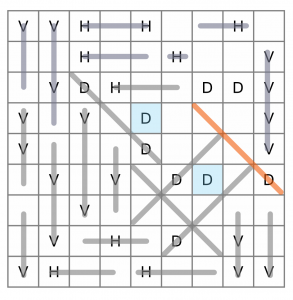
There’s a pair of Ds that only have one place to go, so we’ll draw that line in.
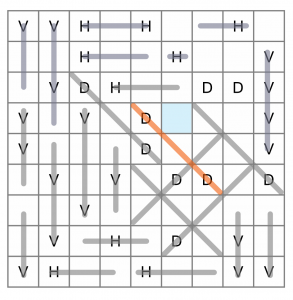
Still working our way up, we’ve got another highlighted cell with only one way to go – another diagonal. We’ll draw that one in too.
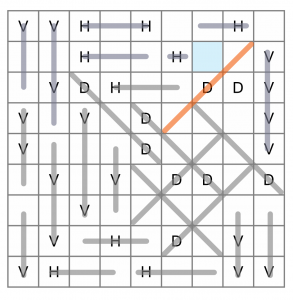
If we draw our attention to the cell highlighted in blue, we can see that with this latest diagonal in place, it can no longer form part of a horizontal line with the cell to its left, because it would only be two cells wide. So that cell must be a diagonal, no other option. We can draw that in, and at the same time connect that orphaned H to the existing 3-cell horizontal to its left.
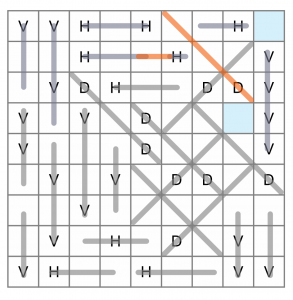
Phew, nearly there! We only have two cells remaining. The very top right must be part of the horizontal line to its left, because that line isn’t long enough yet (all lines must be three or four cells long).
The final cell on row four must be an extension of the diagonal - no other option.
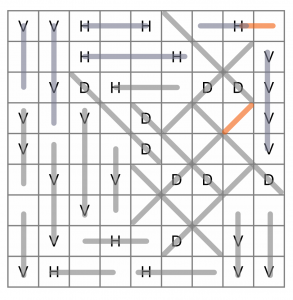
That’s it - we've solve the puzzle!
Ready to have a go yourself? We’ve put together a taster of four puzzles for you, including the example above. You can download and print the PDF below. Solutions are included, but no cheating!
Download Our Line Segment Taster
We include Line Segment in Puzzle Weekly from time to time. Puzzle Weekly is our free weekly puzzle magazine – find out more, and get your copy, here.